Biggest Herbivore Dinosaurs
Table of Contents
Believe it or not, carnivores made up only 35% of the overall dinosaur population. The remaining 65% were herbivores! It is important to note that the special adaptations of these herbivorous dinosaurs’ teeth and digestive tract contributed significantly to their success.
These plant-eating dinosaurs must have eaten a lot of plants every day. They had special teeth that allowed them to break apart tree bark and twigs. They might also keep some of the food in pouches in their cheeks while looking for more to eat. They would occasionally eat small rocks to try and break up the plants in their stomachs.
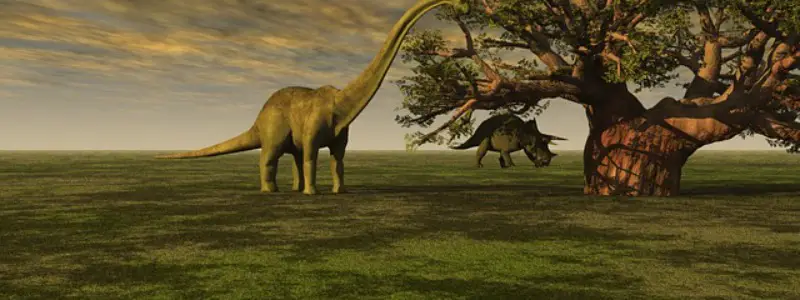
Amargasaurus
For a Sauropod, or large plant eating dinosaur, Amargasaurus was actually quite small. Like most other Sauropod Dinosaurs, Amargasaurus had five digits, or toes on each of its four feet, with the largest containing a large claw.
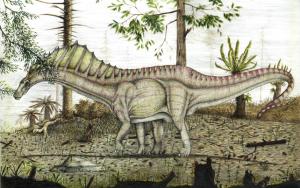
One unique feature found on Amargasaurus was a double sail. It is believed that this sail may have been used to regulate its body temperature. Another possible use was to make it look bigger.
Amargasaurus lived in a time and place where huge meat-eating dinosaurs roamed the landscape. Its smaller size made it a target for these hunters. Sails might have confused these predators making them think Amargasaurus was larger than it actually was.
- What is this dinosaur’s name? Amargasaurus
- How do I pronounce it? Ah-mar-gah-sore-uss
- What does its name mean? The Amarga Reptile
- How long was this dinosaur? 35.00 feet, 10.00 meters
- How heavy was this dinosaur? 14000.00 pounds
- What class was this dinosaur assigned to? Sauropoda
- What did this dinosaur eat? Plants
- How many years ago did this dinosaur live? 130,000,000 Years Ago
- In what period did this dinosaur live? Early Cretaceous
- Where did this dinosaur live? Argentina, South America
Ampelosaurus
Ampelosaurus was discovered and named in 1869 by Philippe Matherson, in Europe.
Living during the Late Cretaceous Period this dinosaur was one of the last sauropods to have roamed the Earth.
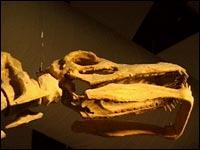
Like other sauropods of the age, Ampelosaurus breathed through nostrils on the top of its head. It is believed that this dinosaur had horn-like lumps on its back.
- What is this dinosaur’s name? Ampelosaurus
- How do I pronounce it? Am-pell-owe-sore-uss
- What does its name mean? Vinyard Reptile
- How long was this dinosaur? 40.00 feet, 12.00 meters
- How heavy was this dinosaur? 20000.00 pounds
- What class was this dinosaur assigned to? Sauropoda
- What did this dinosaur eat? Plants
- How many years ago did this dinosaur live? 72,000,000 Years Ago
- In what period did this dinosaur live? Late Cretaceous
- Where did this dinosaur live? Europe, France, Spain
Apatosaurus
Apatosaurus is one of the most famous dinosaurs of all time. Haven’t heard of it? Well, what about Brontosaurus?
In the early 1900s A famous dinosaur scientist or palaeontologist by the name of Othniel Charles Marsh discovered what he thought were three separate species of dinosaurs. He named one Apatosaurus, one Brontosaurus, and one Atlantosaurus. However, after much study, it became clearer that the three were actually the same animal. Since the first one named was Apatosaurus, that became the official name. Yet the name Brontosaurus has lived on in popular culture.
Apatosaurus had a short snout filled with weak peg like teeth, which it used to rake leafs off of trees. All though not as tall as some of the other Sauropods, it was was one of the heaviest.
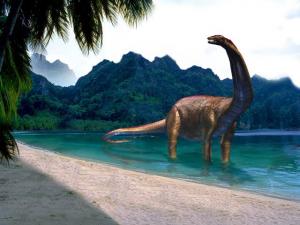
- What is this dinosaur’s name? Apatosaurus
- How do I pronounce it? Ap-at-owe-sore-uss
- What does its name mean? Deceptive Reptile
- How long was this dinosaur? 75.00 feet, 23.00 meters
- How heavy was this dinosaur? 75000.00 pounds
- What class was this dinosaur assigned to? Theropoda
- What did this dinosaur eat? Plants
- How many years ago did this dinosaur live? 150,000,000 Years Ago
- In what period did this dinosaur live? Late Jurassic
- Where did this dinosaur live? Mexico, North America
Argentinosaurus
Few if any land animals have ever lived that were as large as Argentinosaurus. Discovered in 1993 by two paelentologists in Argentina, Argentinosaurus used its incredible size to protect itself from predators.
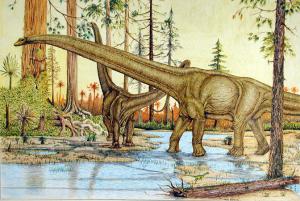 Argentina has been the site of many exciting dinosaur discoveries in recent years, including Giganotosaurus. Giganotosaurus was like a super-sized T-Rex. This predator may have been large enough to feed on sick or young Argentinosaurusus.
Argentina has been the site of many exciting dinosaur discoveries in recent years, including Giganotosaurus. Giganotosaurus was like a super-sized T-Rex. This predator may have been large enough to feed on sick or young Argentinosaurusus.
- What is this dinosaur’s name? Argentinosaurus
- How do I pronounce it? Are-jen-teen-owe-sore-uss
- What does its name mean? Reptile of Argentina (Location of Discovery)
- How long was this dinosaur? 131.00 feet, 40.00 meters
- How heavy was this dinosaur? 200000.00 pounds
- What class was this dinosaur assigned to? Sauropoda
- What did this dinosaur eat? Plants
- How many years ago did this dinosaur live? 85,000,000 Years Ago
- In what period did this dinosaur live? Mid-Cretaceous
- Where did this dinosaur live? Argentina, South America
Barapasaurus
This early Sauropod was discovered in India in 1961. Very few dinosaur fossils are ever found on India, making this an important dinosaur. In order to support its massive appetite, Barapasaurus did not have time to chew its food. Instead it used its teeth to rake in leaves, and swallow them whole. These leaves would then be ground up in its stomach by stones it had swallowed.
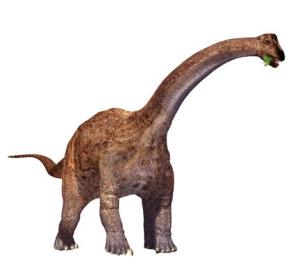
- What is this dinosaur’s name? Barapasaurus
- How do I pronounce it? Bah-rarr-pah-sore-uss
- What does its name mean? Large Legged Reptile
- How long was this dinosaur? 66.00 feet, 20.00 meters
- How heavy was this dinosaur? 50000.00 pounds
- What class was this dinosaur assigned to? Sauropoda
- What did this dinosaur eat? Plants
- How many years ago did this dinosaur live? 200,000,000 Years Ago
- In what period did this dinosaur live? Early Jurassic
- Where did this dinosaur live? Asia, India
Barosaurus
Barosaurus was an amazingly large animal. When standing on its hind legs, this plant eating beast would have been as tall as a five story building.
Barosaurus was discovered in the 1890s by one of the most famous American Paleontologists, Othniel Charles Marsh, it what would later be Dinosaur National Monument, Utah, North America.
Most of Barosaurus’ incredible length would have been made up of its neck, and its tail. Probably only about one fifth would have been its actual body. Imagine trying to lift and move that long of a neck. Fortunately for Barosaurus its neck bones were hollow, and very light, making it easier. Its head would have been small, and light as well.
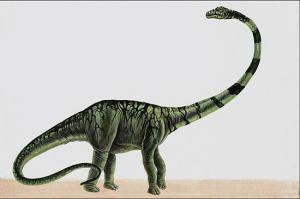
- What is this dinosaur’s name? Barosaurus
- How do I pronounce it? Bar-oh-sore-uss
- What does its name mean? Heavy Reptile
- How long was this dinosaur? 89.00 feet, 27.00 meters
- How heavy was this dinosaur? 60000.00 pounds
- What class was this dinosaur assigned to? Sauropoda
- What did this dinosaur eat? Plants
- In what period did this dinosaur live? Late Jurassic
- Where did this dinosaur live? South Dakota, Africa, North America, Utah
Brachiosaurus
Brachiosaurus is the largest and heaviest land animal ever discovered. This massive animal was different from other large plant-eating Sauropods in a few key ways. Firstly, Brachiosaurus had longer forelegs than hind legs. This gave Brachiosaurus a larger than average profile. Brachiosaurus also had a ridge along the top of its head.
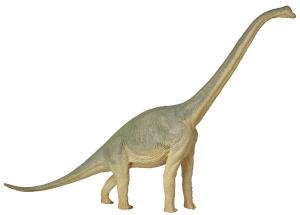
- What is this dinosaur’s name? Brachiosaurus
- How do I pronounce it? Brack-ee-owe-sore-uss
- What does its name mean? Arm Reptile
- How long was this dinosaur? 85.00 feet, 25.00 meters
- How heavy was this dinosaur? 160000.00 pounds
- What class was this dinosaur assigned to? Sauropoda
- What did this dinosaur eat? Plants
- How many years ago did this dinosaur live? 150000000 Years Ago
- Where did this dinosaur live? Africa, Colorado, Europe, North America, Portugal, Tanzania
Camarasaurus
This medium sized sauropod lived around 150 million years ago. Many fossil specimens make Camarasaurus one of the most well known of all North American dinosaurs.
Camarasaurus had front and hind legs of equal length, making its back level with the ground. Camarasaurus’ bones were filled with chambers of air, which is where it gets its name. These air chambers helped reduce its weight. The skull of Camarasaurus was short, compared to other sauropods.
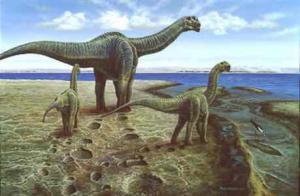
- What is this dinosaur’s name? Camarasaurus
- How do I pronounce it? Cam-are-ah-sore-uss
- What does its name mean? Chambered Reptile
- How long was this dinosaur? 60.00 feet, 18.00 meters
- How heavy was this dinosaur? 40000.00 pounds
- What class was this dinosaur assigned to? Sauropoda
- What did this dinosaur eat? Plants
- How many years ago did this dinosaur live? 150,000,000 Years Ago
- In what period did this dinosaur live? Late Jurassic
- Where did this dinosaur live? Colorado, New Mexico, North America, Portugal, Utah, Wyoming
Cetiosaurus
Discovered in 1809 and studies by Richard Owen, it was originally believed that Cetiosaurus was a whale. In fact the name Cetiosaurus means whale reptile. A few decades later scientists began to discover and name other dinosaurs. After finding a complete skeleton in 1869, they realized that Cetiosaurus was not a whale, but instead a saurpod from the Middle Jurassic Period.
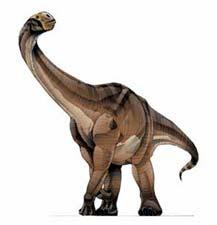
- What is this dinosaur’s name? Cetiosaurus
- How do I pronounce it? Set-ee-owe-sore-uss
- What does its name mean? Wale Reptile
- How long was this dinosaur? 59.00 feet, 18.00 meters
- How heavy was this dinosaur? 40000.00 pounds
- What class was this dinosaur assigned to? Sauropoda
- What did this dinosaur eat? Plants
- How many years ago did this dinosaur live? 175,000,000 Years Ago
- In what period did this dinosaur live? Middle Jurassic
- Where did this dinosaur live? England, Europe
Chubutisaurus
Chubutisaurus was one of the final Sauropods to roam the Earth. This large, long-necked animal probably had a humped shape back, covered in small bumps.
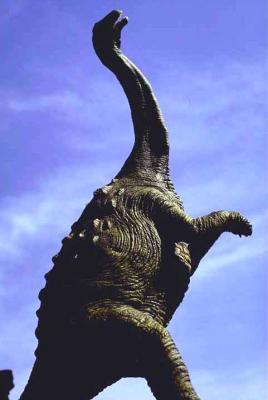 Like other dinosaurs of this type, it is believed that Chubutisaurus used its rake like teeth to gather leaves, and swallow them whole. Like modern birds, Chubutisaurus would have also swallowed stones, which it used in its stomach to grind up the plant matter.
Like other dinosaurs of this type, it is believed that Chubutisaurus used its rake like teeth to gather leaves, and swallow them whole. Like modern birds, Chubutisaurus would have also swallowed stones, which it used in its stomach to grind up the plant matter.
- What is this dinosaur’s name? Chubutisaurus
- How do I pronounce it? Hoo-boot-ee-sore-uss
- What does its name mean? Reptile of Chubut (Location of Discovery)
- How long was this dinosaur? 78.50 feet, 24.00 meters
- How heavy was this dinosaur? 50000.00 pounds
- What class was this dinosaur assigned to? Sauropoda
- What did this dinosaur eat? Plants
- How many years ago did this dinosaur live? 85,000,000 Years Ago
- In what period did this dinosaur live? Mid-Cretaceous
- Where did this dinosaur live? Argentina, South America
Dicraeosaurus
Dicraeosaurus was a medium sized Sauropod. Calling an animal this large a medium sized anything, says something about just how large the Sauropods were.
 Fossils indicate that Dicraeosaurus may have had a small sail on its back, which could have been used to regulate temperature. Most dinosaurs are believed to have been cold-blooded. This means that as the air around them cooled, so did their bodies. They lacked the ability to generate their own heat. A sail would have allowed Dicraeosaurus and other sailed dinosaurs to gather in sunlight, and pass warmth to their bodies through their blood.
Fossils indicate that Dicraeosaurus may have had a small sail on its back, which could have been used to regulate temperature. Most dinosaurs are believed to have been cold-blooded. This means that as the air around them cooled, so did their bodies. They lacked the ability to generate their own heat. A sail would have allowed Dicraeosaurus and other sailed dinosaurs to gather in sunlight, and pass warmth to their bodies through their blood.
- What is this dinosaur’s name? Dicraeosaurus
- How do I pronounce it? Die-kree-owe-sore-uss
- What does its name mean? Double-Forked Reptile
- How long was this dinosaur? 65.00 feet, 20.00 meters
- How heavy was this dinosaur? 22000.00 pounds
- What class was this dinosaur assigned to? Sauropoda
- What did this dinosaur eat? Plants
- How many years ago did this dinosaur live? 150000000 Years Ago
- Where did this dinosaur live? Tanzania, Africa
Diplodocus
This late Jurassic Sauropod thrived in a time when the Earth’s warm temperatures encouraged rapid plant growth. Diplodocus needed a lot of food to keep it alive. Using rake like teeth, this animal could have striped an area of any vegetation, very quickly. Especially considering that there is evidence they traveled in herds.
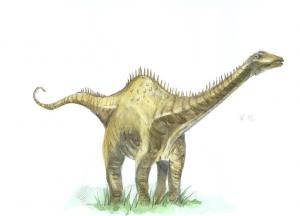 Diplodocus has one of the longest tails of any animal to have ever walked the earth, at around 45 feet. Like most Sauropods, Diplodocus’ nostrils were actually high on its forehead, instead of at the end of its snout. A recently discovered fossil of a skin impression suggests that this animal had spins along its neck.
Diplodocus has one of the longest tails of any animal to have ever walked the earth, at around 45 feet. Like most Sauropods, Diplodocus’ nostrils were actually high on its forehead, instead of at the end of its snout. A recently discovered fossil of a skin impression suggests that this animal had spins along its neck.
- What is this dinosaur’s name? Diplodocus
- How do I pronounce it? Dip-lod-ic-uss
- What does its name mean? Double Beam
- How long was this dinosaur? 90.00 feet, 27.00 meters
- How heavy was this dinosaur? 27000.00 pounds
- What class was this dinosaur assigned to? Sauropoda
- What did this dinosaur eat? Plants
- How many years ago did this dinosaur live? 150,000,000 Years Ago
- In what period did this dinosaur live? Late Jurassic
- Where did this dinosaur live? Colorado, North America, Wyoming
Euhelopus
Discovered in China in 1929, Euhelopus was the first official Sauropod discovery in China. This medium-sized sauropod had equal sized front and back legs, a long neck, and a box shaped skull.
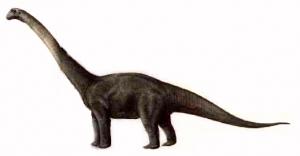
- What is this dinosaur’s name? Euhelopus
- How do I pronounce it? You-hel-owe-puss
- What does its name mean? Good Marsh Foot
- How long was this dinosaur? 50.00 feet, 15.00 meters
- How heavy was this dinosaur? 50000.00 pounds
- What class was this dinosaur assigned to? Sauropoda
- What did this dinosaur eat? Plants
- In what period did this dinosaur live? Late Jurassic
- Where did this dinosaur live? Asia, China
Haplocanthosaurus
Haplocanthosaurus was discovered by John Bell Hatcher in 1901, near Canyon City, Colorado, USA. This type of dinosaur lived for many millions of years, and was found throughout the Earth.
Like other Saurpods, Haplocanthosaurus breathed through nostrils found in the top of its head. This large animal spent its time lumbering slowly in search of food.
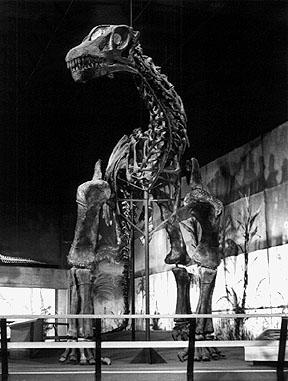 Large sauropods would have required a tremendous amount of food to feed their monstrous metabolisms.
Large sauropods would have required a tremendous amount of food to feed their monstrous metabolisms.
- What is this dinosaur’s name? Haplocanthosaurus
- How do I pronounce it? Hap-low-kna-thoe-sore-uss
- What does its name mean? Single Spiked Dinosaur
- How long was this dinosaur? 70.00 feet, 21.00 meters
- How heavy was this dinosaur? 40000.00 pounds
- What class was this dinosaur assigned to? Sauropoda
- What did this dinosaur eat? Plants
- How many years ago did this dinosaur live? 150,000,000 Years Ago
- In what period did this dinosaur live? Late Jurassic
- Where did this dinosaur live? Colorado, North America, Wyoming
Janenschia
Living around 150 million years ago, during a time of great warmth around the world, Janenschia was one of the largest Sauropods to have lived. Unique from other Sauropods, Janenschia had claws on its hind feet. It is believed that most other Sauropods had only one claw on each digit.
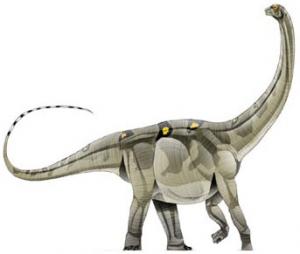 Janenschia was named after a German paleontologist by the name of Werner Janensch.
Janenschia was named after a German paleontologist by the name of Werner Janensch.
- What is this dinosaur’s name? Janenschia
- How do I pronounce it? Yan-en-schee-ah
- What does its name mean? For Janensch
- How long was this dinosaur? 79.00 feet, 24.00 meters
- How heavy was this dinosaur? 60000.00 pounds
- What class was this dinosaur assigned to? Sauropoda
- What did this dinosaur eat? Plants
- How many years ago did this dinosaur live? 150,000,000 Years Ago
- In what period did this dinosaur live? Late Jurassic
- Where did this dinosaur live? Africa
Jobaria
Jobaria was a huge dinosaur who belonged to the Sauropoda group. Scientists believe that Jobaria was not closely related to any other sauropod however. Instead, it is thought that this large plant eater was probably a left-over from an earlier age of dinosaurs.
Jobaria had a shorter neck, and less complex bone structure that most other sauropods. The dinosaur was discovered in 1997 by a team of paleontologists in Niger, Africa. These scientsists found 95% of an adult animal, and a complete skeleton from a younger animal, along with parts from many other animals of the same species. It is believed that they were probably killed in a large single event such as a flash flood.
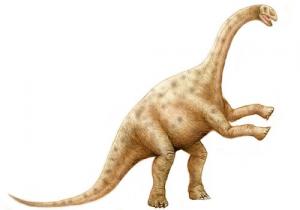
- What is this dinosaur’s name? Jobaria
- How do I pronounce it? Joe-bar-ee-ah
- What does its name mean? Of Jobar
- How long was this dinosaur? 60.00 feet, 21.00 meters
- How heavy was this dinosaur? 40000.00 pounds
- What class was this dinosaur assigned to? Sauropoda
- What did this dinosaur eat? Plants
- How many years ago did this dinosaur live? 135,000,000 Years Ago
- In what period did this dinosaur live? Early Cretaceous
- Where did this dinosaur live? Africa, Niger
Mamenchisaurus
Mamenchisaurus lived around 155 million years ago during a very warm and wet period of the Earth’s history. This dinosaur may have had the longest neck of any other dinosaur. Many paleontologists believe that it used its massive neck to eat foliage on the ground. They believe that Mamenchisaurus would have swung its neck in a giant arc, eating everything it could eat. Than it would have taken a step forward, and started the process over again.
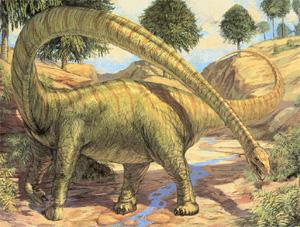 Scientists used to think that Mamenchisaurus lived in swamps, and floated its head at the top of the water where it could eat water plants. This idea is no longer accepted however.
Scientists used to think that Mamenchisaurus lived in swamps, and floated its head at the top of the water where it could eat water plants. This idea is no longer accepted however.
- What is this dinosaur’s name? Mamenchisaurus
- How do I pronounce it? Ma-man-chee-sore-uss
- What does its name mean? Mamen Reptile
- How long was this dinosaur? 80.00 feet, 25.00 meters
- How heavy was this dinosaur? 30000.00 pounds
- What class was this dinosaur assigned to? Sauropoda
- What did this dinosaur eat? Plants
- How many years ago did this dinosaur live? 155,000,000 Years Ago
- In what period did this dinosaur live? Late Jurassic
- Where did this dinosaur live? Asia, China
Opisthocoelicaudia
This large sauropod was discovered in 1965 in the Gobi Desert. This animal was shorter than many other sauropods, but was also heavier than most, meaning that its body was large and compact.
The fossils found lacked the skull and most of the neck.
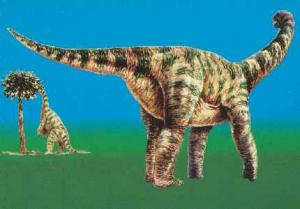
- What is this dinosaur’s name? Opisthocoelicaudia
- How do I pronounce it? Owe-piss-thoe-seel-ee-cawd-ee-ah
- What does its name mean? Hollow-backed-tailbone
- How long was this dinosaur? 40.00 feet, 12.00 meters
- How heavy was this dinosaur? 40000.00 pounds
- What class was this dinosaur assigned to? Sauropoda
- What did this dinosaur eat? Plants
- How many years ago did this dinosaur live? 70,000,000 Years Ago
- In what period did this dinosaur live? Late Cretaceous
- Where did this dinosaur live? Asia, Mongolia
Quaesitosaurus
Quaesitosaurus was a medium sized Sauropod, but a very large Dinosaur overall. Very little of this animal have actually been found in the fossil record. Most of what we think this animal looked like is, as a result, based purely on guesswork.
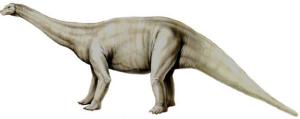 Quaesitosaurus had very small soft teeth, which it may have used to eat water plants.
Quaesitosaurus had very small soft teeth, which it may have used to eat water plants.
- What is this dinosaur’s name? Quaesitosaurus
- How do I pronounce it? Kye-sit-owe-sore-uss
- What does its name mean? Unusual Reptile
- How long was this dinosaur? 43.00 feet, 13.00 meters
- How heavy was this dinosaur? 20000.00 pounds
- What class was this dinosaur assigned to? Sauropoda
- What did this dinosaur eat? Plants, Possibly Water Plants
- How many years ago did this dinosaur live? 75000000 Years Ago
- Where did this dinosaur live? Asia, China, Mongolia
Rhoetosaurus
Rhoetosaurus is one of just a couple sauropods believed to have lived on the continent of Australia. This dinosaur is very similar to other sauropods of the age, such as Shunosaurus from China.
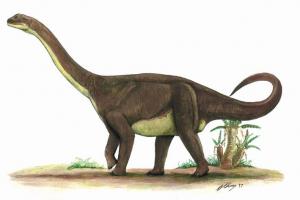 Rhoetosaurus was discovered in Queensland, Australia in 1924 by Heber Longman. This heavy animal had powerful elephant-like legs which it used to support its body. Some paleontologists believe that Rhoetosaurus had a spiked club-like tail, but there is no fossil evidence to prove this.
Rhoetosaurus was discovered in Queensland, Australia in 1924 by Heber Longman. This heavy animal had powerful elephant-like legs which it used to support its body. Some paleontologists believe that Rhoetosaurus had a spiked club-like tail, but there is no fossil evidence to prove this.
- What is this dinosaur’s name? Rhoetosaurus
- How do I pronounce it? Reet-owe-sore-uss
- What does its name mean? Trojan Reptile
- How long was this dinosaur? 60.00 feet, 18.00 meters
- How heavy was this dinosaur? 40000.00 pounds
- What class was this dinosaur assigned to? Sauropoda
- What did this dinosaur eat? Plants
- How many years ago did this dinosaur live? 180,000,000 Years Ago
- In what period did this dinosaur live? Middle Jurassic
- Where did this dinosaur live? Queensland, Australia
Saltasaurus
Discovered and named in 1980, Saltasaurus is a very unique and interesting Sauropod. Fossil evidence shows that Saltasaurus had thousands of spines that covered its entire body, similar to a pin cushion.
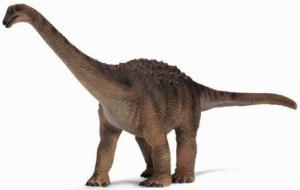 In addition to spines, Saltasaurus also had a number of fist-sized lumps spread across its back.
In addition to spines, Saltasaurus also had a number of fist-sized lumps spread across its back.
Living during the mid and late Cretaceous Period these were among the smallest and last surviving of all the Sauropods anywhere on Earth.
- What is this dinosaur’s name? Saltasaurus
- How do I pronounce it? Sall-tah-sore-us
- What does its name mean? Salta Reptile (Location of Discovery)
- How long was this dinosaur? 39.00 feet, 12.00 meters
- How heavy was this dinosaur? 20000.00 pounds
- What class was this dinosaur assigned to? Sauropoda
- What did this dinosaur eat? Plants
- How many years ago did this dinosaur live? 75,000,000 Years Ago
- In what period did this dinosaur live? Late Cretaceous
- Where did this dinosaur live? Uruguay, Argentina, South America
Sauroposeidon
Sauroposeidon is quite possibly the tallest dinosaur to have ever walked the Earth. This tower of an animal was so large it could have peaked at residents living in a sixth story apartment building.
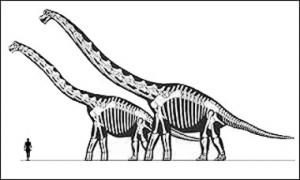 Sauroposeidon lived in the wet and warm landscapes of the late Cretaceous Period about 110 million years ago.
Sauroposeidon lived in the wet and warm landscapes of the late Cretaceous Period about 110 million years ago.
Scientists are not entirely certain just how large this dinosaur was. What we know about it is based on just a few bones discovered in Oklahoma in 1994 by Bobby Cross.
- What is this dinosaur’s name? Sauroposeidon
- How do I pronounce it? Sore-owe-pos-eye-don
- What does its name mean? Poseidon Dinosaur
- How long was this dinosaur? 89.00 feet, 30.00 meters
- How heavy was this dinosaur? 130000.00 pounds
- What class was this dinosaur assigned to? Sauropoda
- What did this dinosaur eat? Plants
- How many years ago did this dinosaur live? 110,000,000 Years Ago
- In what period did this dinosaur live? Late Cretaceous
- Where did this dinosaur live? Texas, North America, Oklahoma
Seismosaurus
In the early 1990s blockbuster movie Jurassic park, the characters knew a dinosaur was approaching, because the ground shook with every step the animals took.
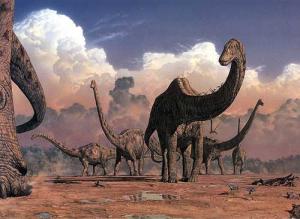 The name Seismosaurus actually means “Earthquake Reptile”, because this Dinosaur was large enough that it may actually have shook the ground as it walked. An almost unimaginably large animal, Seismosaurus lived during a time, when the Earth’s warm temperatures encouraged rapid plant growth. This helped to insure an ample supply of food.
The name Seismosaurus actually means “Earthquake Reptile”, because this Dinosaur was large enough that it may actually have shook the ground as it walked. An almost unimaginably large animal, Seismosaurus lived during a time, when the Earth’s warm temperatures encouraged rapid plant growth. This helped to insure an ample supply of food.
Seismosaurus probably used a rake like set of teeth to quickly clear the leafs off of nearby trees, and swallowed them without chewing. Alongside the bones of Seismosaurus were also found many small round stones, that Seismosaurus swallowed to help grind up their food.
- What is this dinosaur’s name? Seismosaurus
- How do I pronounce it? Size-mow-sore-uss
- What does its name mean? Earthquake Reptile
- How long was this dinosaur? 170.00 feet, 50.00 meters
- How heavy was this dinosaur? 100000.00 pounds
- What class was this dinosaur assigned to? Sauropoda
- What did this dinosaur eat? Plants
- How many years ago did this dinosaur live? 150,000,000 Years Ago
- In what period did this dinosaur live? Late Jurassic
- Where did this dinosaur live? New Mexico, North America
Shunosaurus
An early sauropod living in the Mid-Jurassic Period, Shunosaurus is believed to have been the ancestor to dozens of later sauropods.
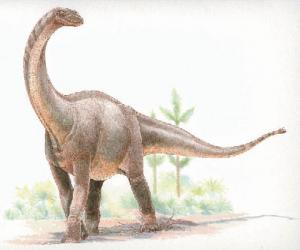 Shunosaurus is well-known from over 20 fossil specimens, including several skulls. It is unusual to find so many skulls from a single type of sauropod. This large animal was discovered in 1983 in the shuozhou area of China. Shunosaurus’ front and hind legs were similar in length, making its back relatively level with the ground. The most noticable feature on this dinosaur were the large spikes covering its club-like tail.
Shunosaurus is well-known from over 20 fossil specimens, including several skulls. It is unusual to find so many skulls from a single type of sauropod. This large animal was discovered in 1983 in the shuozhou area of China. Shunosaurus’ front and hind legs were similar in length, making its back relatively level with the ground. The most noticable feature on this dinosaur were the large spikes covering its club-like tail.
- What is this dinosaur’s name? Shunosaurus
- How do I pronounce it? Shoo-noe-sore-uss
- What does its name mean? Shuo Reptile (Location of Discovery)
- How long was this dinosaur? 36.00 feet, 11.00 meters
- How heavy was this dinosaur? 20000.00 pounds
- What class was this dinosaur assigned to? Sauropoda
- What did this dinosaur eat? Plants
- How many years ago did this dinosaur live? 180,000,000 Years Ago
- In what period did this dinosaur live? Middle Jurassic
- Where did this dinosaur live? Asia, China
Supersaurus
A truly massive animal, Supersaurus might have been as large as 130 feet. Like other Sauropods, this Dinosaur probably spent its days either looking for food, or eating. It takes a lot of food to fuel a beast as large as Supersaurus. To increase the speed at which it could get food, Supersaurus did not chew. Instead, it swallowed its food whole.
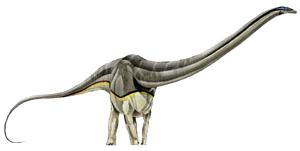 Supersaurus’ teeth were shaped like the pegs of a rake, and it used them to in effect rake the leafs and vegetation off of surrounding trees. This animal may have been the longest, but not the heaviest of all the Dinosaurs.
Supersaurus’ teeth were shaped like the pegs of a rake, and it used them to in effect rake the leafs and vegetation off of surrounding trees. This animal may have been the longest, but not the heaviest of all the Dinosaurs.
- What is this dinosaur’s name? Supersaurus
- How do I pronounce it? Soo-pur-sore-uss
- What does its name mean? Super Reptile
- How long was this dinosaur? 131.00 feet, 40.00 meters
- How heavy was this dinosaur? 100000.00 pounds
- What class was this dinosaur assigned to? Sauropoda
- What did this dinosaur eat? Plants
- How many years ago did this dinosaur live? 150,000,000 Years Ago
- In what period did this dinosaur live? Late Jurassic
- Where did this dinosaur live? Colorado, North America
Titanosaurus
Titanosaurus was first discovered and named in 1870 in India. What we know about this dinosaur is based on just a few fossils. It was not until 1996 that a good skull specimen was discovered by Ruben Martinez.
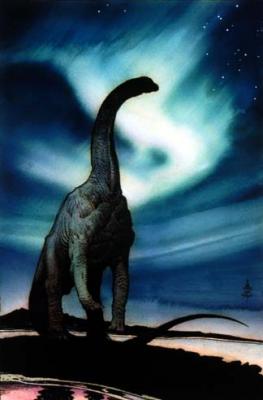 This skull showed that Titanosaurus had a long narrow head, with small evenly spaced teeth similar to a garden rake. It is believed that Titanosaurus may have had a number of spike-like lumps, and a line of dragon-like spines.
This skull showed that Titanosaurus had a long narrow head, with small evenly spaced teeth similar to a garden rake. It is believed that Titanosaurus may have had a number of spike-like lumps, and a line of dragon-like spines.
- What is this dinosaur’s name? Titanosaurus
- How do I pronounce it? Tie-tan-owe-sore-uss
- What does its name mean? Very Large Reptile
- How long was this dinosaur? 60.00 feet, 18.00 meters
- How heavy was this dinosaur? 20000.00 pounds
- What class was this dinosaur assigned to? Sauropoda
- What did this dinosaur eat? plants
- How many years ago did this dinosaur live? 75,000,000 Years Ago
- In what period did this dinosaur live? Late Cretaceous
- Where did this dinosaur live? India, Argentina, Asia, South America
Vulcanodon
Vulcanodon lived on Earth about 210 million years. Compared to other Sauropods Vulcanodon was actually quite small, and is believed to have been among the very first dinosaurs of its kind to have appeared on the Earth.
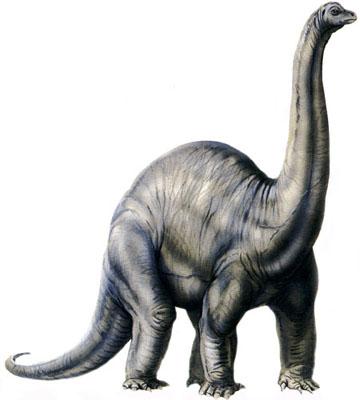 Vulcanodon has many features which resemble the earlier prosauropods. This type of dinosaur were similar to the long-necked Sauropod giants, except that they were smaller, and had important differences in their hip bones.
Vulcanodon has many features which resemble the earlier prosauropods. This type of dinosaur were similar to the long-necked Sauropod giants, except that they were smaller, and had important differences in their hip bones.
- What is this dinosaur’s name? Vulcanodon
- How do I pronounce it? Vul-can-owe-don
- What does its name mean? Vulcan Tooth
- How long was this dinosaur? 23.00 feet, 7.00 meters
- How heavy was this dinosaur? 1700.00 pounds
- What class was this dinosaur assigned to? Sauropoda
- What did this dinosaur eat? Plants
- How many years ago did this dinosaur live? 210,000,000 Years Ago
- In what period did this dinosaur live? Early Jurassic
- Where did this dinosaur live? Zimbabwe, Africa
Ultrasauros
The Ultrasauros may have lived around 150 million years ago during the late Jurassic Period. Actually, this dinosaur may have never lived at all.
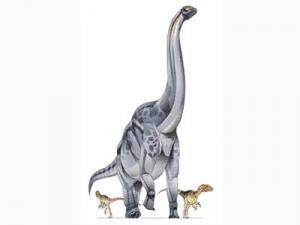 There is much debate today among scientists as to whether or not the fossils attributed to Ultrasauros were really bones from another dinosaur such as Brachiosaurus.
There is much debate today among scientists as to whether or not the fossils attributed to Ultrasauros were really bones from another dinosaur such as Brachiosaurus.
If this animal did exist, it probably spent its life eating plants.
- What is this dinosaur’s name? Ultrasauros
- How do I pronounce it? Ull-tra-sore-oss
- What does its name mean? Ultra Reptile
- How long was this dinosaur? 115.00 feet, 35.00 meters
- How heavy was this dinosaur? 100000.00 pounds
- What class was this dinosaur assigned to? Sauropoda
- What did this dinosaur eat? Plants
- In what period did this dinosaur live? Late Jurassic
- Where did this dinosaur live? Colorado, North America
10 Biggest Herbivorous Dinosaurs That Ever Lived
A herbivore is a type of animal that only eats plants. Carnivores and omnivores frequently prey on them. To counteract this, they have developed various methods of defending themselves or evading the predator.
